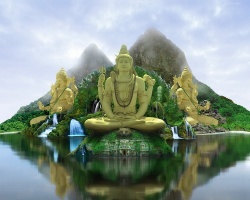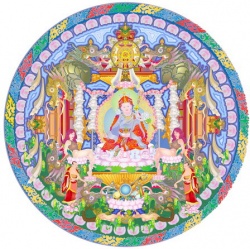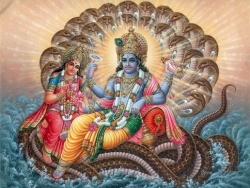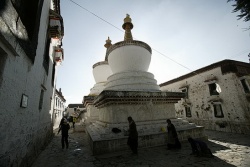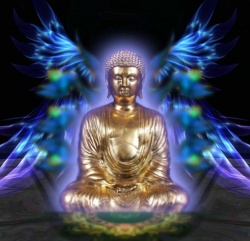Four essential points
Taught by Lopon Tenzin Namdak,
New York city, October 1991,
Transcribed and edited by Vajranatha
The short text we have here is from the "Nam mkha phrul mdzod" collection. Here there are four essential points for understanding the nature of Dzogchen. First Dzogchen does not contradict the Two Truths. Second, in Dzogchen there is no grasping at the view that a self exists. Third the Dzogchenpa's conduct is not just going around doing whatever he wants at the moment. And fourth there is no special apprehension of anything.
As for the first point according to the Sutras it is well known that the Buddha taught the Two Truths: the Relative Truth and the Absolute Truth. They are without question the Buddha s teachings and so when we understand Dzogchen it is important not to speak against these Two Truths. However Dzogchen which is the highest teaching of the Buddha teaches that causality that is to say karmic causes and their consequences is not the highest truth. In the Bonpo tradition we find two methods for proceeding along the path First according to the highest way (Dzogchen) among the Nine Ways the Nature of Mind is empty. Therefore its essence has nothing to do with causality; it is in no way changed or modified by karmic causes and their consequences. It totally transcends them; it is beyond cause and effect and so we say that it is primordial pure (ka dag). A practitioner who has actually attained Buddhahood remaining continuously in the Natural State has nothing to realize as a cause for anything else. He does not expect any virtuous qualities to arise as the consequence of virtuous actions nor does he fear any bad consequences of wrong actions. This is because the Natural State is beyond all karmic causality and its effects. That is why Dzogchen does not speak about karmic causes when referring to the Natural State. But otherwise if the practitioner is not actually in the Natural State (and this is ones usual ordinary Samsaric existence) everything proceeds according to karmic causes. The actions we do will have their consequences.
Second, there is the way of proceeding according to the eight other ways among the Nine Ways of Bon (theg pa rim dgu) that are not Dzogchen in terms of their view and practice. Here matters are mostly understood in terms of Relative Truth and therefore we speak about karmic causes rather extensively. All results whether good or bad arise from causes. In the same way the visions that arise in such practices as Thodgal and dark retreat belong to sphere of Relative Truth (snang lugs kun rdzob bden pa). But the contradiction is only apparent here. From the standpoint of the Natural State we speak in terms of the Absolute Truth. Everything is empty and lacks any inherent existence Dzogchen asserts that the Natural State is beyond causality that it does not rely on any karmic causes. But it does assert that the totality of appearances (snang lugs) depends on causes. This is especially the case with our impure karmic vision and one instance of such impure vision is our human karmic vision our existence as a human being as we know it Karmic vision is brought about by causes and all of us perceive this world as human karmic vision because we all possess the cause for that karmic vision. It is impure because it is caused by ignorance and the passions.
Here we speak of two kinds of practitioners ordinary persons and realized beings or adepts. We should remember that the content of the teachings when they are expressed in words depends on who is the audience listening to the teachings. The fundamental Dzogchen precepts were mainly revealed directly by the Primordial Buddha the Dharmakaya Samantabhadra or Kuntu Zangpo (Kun tu bzang po) and the Dharmakaya always spoke the Truth and never otherwise. The Dharmakaya spoke from the standpoint of the Natural State For this reason Dzogchen does not accept as its view the Two Truths. It accepts only a single Truth or Source called the Unique Essence (thig le nyag gcig). This is the Natural State in which appearances and emptiness are inseparable. However our ordinary visions (impure karmic vision) arise from causes and Dzogchen agrees with that. So if we understand Dzogchen then we do not find any inherent contradiction here. These Truths the Two Truths and the Unique Essence have different meanings. This is the first point.
As for the second point Dzogchen does not grasp at or apprehend a view that a permanent self exists (bdag gi lta ba). In normal life we are always thinking of ourselves. All of our thinking is tied up with this notion of a self [as something real and abiding] and all of our emotional reactions are predicated on this self. The name for this process of constantly creating a self wheres in reality there is none there is grasping at a self (bdag dzin) or self centeredness. Up until now this unconscious process has led us to accumulate negative karmic causes throughout countless lifetimes This Dagdzin or grasping at a self represents ignorance here meaning a lack of real knowledge and awareness (ma rig pa). This ignorance has no absolute beginning in time; it has always been with us in each lifetime as an integral part of the habit of our existence. When we see some thing immediately we accept or reject it. We judge the perceived object to be good or bad and we have a corresponding emotional reaction of attachment or aversion But if we do not have any grasping (dzin pa) at the object (that is the mental process of apprehending and judging a perception) then we will not develop attachment for it.
For this reason we must look back into ourselves and seek to find this so-called self (bdag). How do we think? We think that our perception exists externally to us and it is objective and real It is really there and so we grasp at it. But if we search into this what is it that we grasp? Where is the grasper? It is like opening a series of Chinese boxes. Eventually, we find that there is nothing there to grasp. Look at how we do this grasping or Dzinpa For example we have a headache and so we think Oh I have a headache! Certainly there is the experience of a headache yet this headache is not us Nor is the head us And yet we grasp and think I am sick! But look more closely at this. There is no I existing here only the experience of pain It is the same with the other parts of the body We can examine all of these parts but where do we find any I? This identification process where we predicate an "I to all of our experiences is what we meant by Dagdzin or grasping at a self Yes there exist all these parts belonging to our body but when we pull them an apart even down to the last cell where do we find any I?"
Then we conclude that even though the self (bdag) is not the physical body it must be our mind or consciousness. But we can proceed here with the mind in the same way as we did with the physical body searching for a self or I. We will not find any self. For example, there is eye consciousness If that were not present we would not see anything at all even though the eye organ is present there and functional. A corpse n-tay have its eye organs in tact but it does not see anything because there is no consciousness present But is this eye consciousness the I or not? We can proceed to investigate in the same way all of the other sense consciousnesses in the current of our daily experience We have searched outside through our perceptions and through the parts of our body and have found that there exists no self there. Now we search inside through our sense consciousnesses and find that there exists no self here either. But what of our mind? Is this the self or I ? If we examine the mind we discover that it is not a single unified entity or substance; rather it is a process occurring in time a succession of states of consciousness having varied mental contents It is like a stream or a river that changes from moment to moment It is never the same. Where in these states of consciousness and contents of consciousness do we find a self or I ? We have searched outside and inside exhaustively and what do we find? Where is this self of which we speak so freely? All the things we see and experience are not this so-called self. They are not us and yet we grasp at them as if they were ourselves.
Without there being any certain solid objective reality out there in space still we grasp at perceptions of the world as if they are real Perceived objects do not exist inherently but we do perceive them as if they existed objectively This is Relative Truth External appearances do exist in terms of Relative Truth but this is not the real truth It is ignorance This ignorance has existed from the very beginning until now and it is the source of our circulating in Samsara We may think that My conscious self grasps at an object but there is no object there But this is an illusion also We habitually believe that external objects have an inherent existence but this is not so Nothing exists inherently Otherwise there would be no possibility of change in the world Everything would be locked into its essence or inherent nature But change is our experience So there is no inherent existence yet grasping persists So this consciousness which grasps is not reliable and leads us into error There are perceptions— we see many beautiful and ugly things We judge them as such and feel attachment or aversion for them There is no real object out there that is beautiful or ugly because these judgments are created by our minds but we grasp at these objects In the dark, we mistakenly perceive a pillar as our enemy and we hit it with our fist This enemy did not exist independently; it was created by our minds If we go for a time into a totally dark room our imagination may create many strange effects which we see They may look very real but if we chase them we hit our head against the wall because they are illusions So there is no point in having desires for these phantoms and illusions which are as unreal as dreams If we understand this point our desires and our aversions will decrease.
Even though we cannot find out there any inherent existence still we cannot say that we do not exist because we are doing this grasping We exist because we are engaged in this activity the process of Dzinpa or grasping at perceptions But if we search on the inside for some inherent existence we do not find anything either But this does not mean that we do not exist For example take the individual sitting here named George We can say that he is my son or my friend or my father or my enemy or whatever Everyone in the room here has a different idea of who George really is depending on our relationship to him But who is the real George? If George is my son he cannot be my father Even if he is my son son is not his real essence to the exclusion of anything else To his own son he is my father So George is created by our perception and our consciousness and by our definition of him in relation to us That determines what he is; it defines him So on the object side George has no inherent existence but this does not mean that he is not sitting here right in front of us all On the subject side everything exists because we are conscious and are having perceptions But on the object side nothing exists as a solid unchanging reality Therefore there is no point in feeling attachments or aversions for these appearances To understand this is the real Dharma.
It is not easy to stop the accumulating of negative actions without a strong antidote But through practice this antidote can become quite strong and in this way we can mitigate the influence of the passions These negative emotions will become weaker and grow less because of our practice of meditation Then we will do less harm to others and we will accumulate virtues Just reciting mantras or circumambulating a stupa is not enough It is bringing about a change in our consciousness that is most important.
The third point here means that we as Dzogchen practitioners do not go about acting on our momentary impulses doing whatever we might feel like at that moment At this present time we have this human existence and this human body and that is something not easy to get because it requires the accumulation of a great deal of meritorious karma over countless lifetimes Even if we get a human existence we still may find many difficult conditions such as being born deaf and dumb or being bom in a country where there is no Dharma So we need not only a human rebirth but the opportunity to come into contact with the teachings and the capacity to understand the teachings and practice them We have to examine how we live our lives Because life is impermanent we should not postpone the Dharma to next month or next year and not waste our capacities of body speech and mind We waste our opportunity in this life by not doing any virtuous actions. Thinking bad of others and speaking Ul of them is wasting our minds and our speech It is just stupid to waste our opportunities when we can use our body speech and mind to practice to grow and to develop And so in terms of Dzogchen we must use every opportunity to do meditation practice in order to familiarize ourselves with the Natural State No excuses no saying that we have no time or that we are too busy But what and how long we practice depends on our capacity and our circumstances.
Very well and good We are practicing Dzogchen But the third point means that we cannot simply go about in a libertine fashion doing whatever we like and saying that there is no sin or consequences to our actions. Even though Dzogchen asserts that the Natural State is beyond cause and effect and that karmic causality does not modify to it in any way this applies only to us as practitioners of Dzogchen when we are actually in the Natural State Otherwise our consciousness and our lives are totally under the rule of karrna Most of the time during the day we are not in the Natural State and so karma applies very much to our normal daily thoughts and actions. We are living in the relative condition save only when we actually find ourselves in the Natural State. So to say we can do whatever we like is not the correct view of Dzogchen These momentary desires and impulses we experience are conditioned things created by our unconscious karmic traces to follow after them is not freedom no matter how much we speak about Dzogchen. Only for the Natural State are there no rules or limitations and only in the Natural State is found there total freedom.
As four the fourth point in Dzogchen there is nothing special to be grasped or apprehended. In terms of our ordinary common vision and our daily life we can say that everything is an illusion and created by our consciousness. If we really understand this then there is no point in grasping strongly at anything, for example as their being our enemies or our friends. We are not attached too much to anything; we do not grasp at wealth or possessions. Nothing is special. We come to understand that in terms of their reality everything is equal. All things are equally empty and an things are equally illusion. If we understand that all things are in fact illusions then there is no point in having negative emotions with regard to them. All of life is like a dream We see it yes but in the end it dissolves and leaves no trace. But we, the Natural State remain. So these are four essential points to remember.
